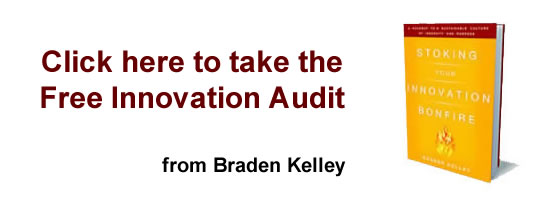5 Ways to Defeat the Innovation Myth
 Busting the alluring lie that a good idea is all it takes to be more innovative.
Busting the alluring lie that a good idea is all it takes to be more innovative.
Peter Drucker used to say, “Good intentions don’t move mountains; Bulldozers do!” I’d like to modify that by swapping the word “ideas” for “intentions.” Anathema! Ideas are the mother’s milk of innovation, right? Not so quick; hear me out.
In 30 years of running and advising start-ups there is one thing that has consistently amused me; I call it “The Innovation Myth.” It goes something like this; you’re always just one good idea away from your next blockbuster product. A tantalizing thought that seduces many small businesses and startups into believing that coming up with an idea is the hardest part of innovation. That couldn’t be further from the truth.
The Mythology of Innovation: You’re always just one good idea away from your next blockbuster product.
Ideas are never in short supply and the really good ones seem to spontaneously ignite in many minds. The more connected we get the more that will be the case and the less protection patents will afford. The key isn’t just coming up with a great idea, it’s getting from idea to innovation as fast as possible.
Still we’ve all been weaned on stories about inventors who stumble upon an idea, from penicillin to Post-it Notes, Gore-Tex to Google; simple ideas and small serendipitous occurrences which create the alluring myth that a good idea is all it takes to change the world.
The Idea
For example, most of us know that the microwave oven was discovered in a chance encounter when Percy Spencer’s candy bar melted in his pocket while he was working on combat radar for Raytheon in 1945. Spencer tried a few other food items, including a exploding egg–an apt metaphor to punctuate the inception of a great idea. The invention was patented, and soon the smell of RadarRange popcorn was wafting throughout the land. That’s the story, right? Wrong.
The Innovation
Twenty years later it was George Freedman–not coincidentally, a small business owner prior to joining Raytheon–who created the innovation. Freedman was frustrated by how ideas could not make it from invention to innovation and wanted to break out of traditional R&D to create a protected space for ideas to flourish. His efforts resulted in the New Product Center (NPC) at Raytheon, which, after another 10 years, resulted in the successful commercialization of the microwave oven. Was it not for Freedman’s “process” of innovation the “idea” of a microwave may well have ended up in the graveyard of great ideas–where most new ideas end up. Freedman’s innovation was not the product, it was the process.
So, how do you create the sort of organization that can quickly get from idea to innovation? First stop asking, “Where will the next idea come from?” You’re asking the wrong question. Ideas are everywhere. Instead ask, “How can I build bulldozers to plow the path from idea to innovation?”
Five Ways to Defeat the Innovation Myth:
-
- Get accustomed to building for the unknown. — Ideas most often stall because they are unprovable. Embrace the risk of the unknowable; otherwise you, and your customers, are anchored in the past. If you wait for certainty you’ll forever be trying to play catch-up with innovators. If this one is tough to wrap your brain around think of the near-death experience of the US automotive industry.
-
- Fail fast, get over it and move on — Most ideas will fail; get over it. The key is to define the “acceptable scope” of failure. The worst thing to do is to try to avoid failure at all costs by penalizing your employees for experimenting. That’s a guarantee that you’ll never get out of the idea stage. One of my clients actually has a budget they set aside for hedge bets on taking outrageous ideas to market.
-
- Abandon the success of the past. — Don’t let the limits of the past define the limits of the future. Context, markets, technology all change. Getting from idea to innovation requires letting go of old models that define the past. Walking away from success is hard, even long after it’s clear that the world has changed. Need proof? Remember Blockbuster?
-
- Focus on process; not product. — Don’t get infatuated with the idea. No idea is born fully formed; only the market can shape it. Be ready and receptive to surprises and focus on the process of innovating. That’s what Freedman created at Raytheon.
- Challenge conventional wisdom. — Rather than cling to how an idea fits into what a product or service is “supposed to be,” challenge conventional wisdom and consider new and outrageous ways to solve old problems. Think of what iRobot did with the Roomba. They didn’t ask “How do you vacuum better?” but “How do you not vacuum at all?”
This article was originally published on Inc.
Wait! Before you go…
Choose how you want the latest innovation content delivered to you:
- Daily — RSS Feed — Email — Twitter — Facebook — Linkedin Today
- Weekly — Email Newsletter — Free Magazine — Linkedin Group
 Tom Koulopoulos is the author of 10 books and founder of the Delphi Group, a 25-year-old Boston-based think tank and a past Inc. 500 company that focuses on innovation and the future of business. He tweets from @tkspeaks.
Tom Koulopoulos is the author of 10 books and founder of the Delphi Group, a 25-year-old Boston-based think tank and a past Inc. 500 company that focuses on innovation and the future of business. He tweets from @tkspeaks.
NEVER MISS ANOTHER NEWSLETTER!
LATEST BLOGS
Three things you didn’t know about credit cards
Photo by Ales Nesetril on Unsplash Many of us use credit cards regularly. From using them for everyday purchases to…
Read MoreFive CV skills of a business-minded individual
Photo by Scott Graham on Unsplash The skills listed on a CV help employers quickly understand your suitability for a…
Read More


